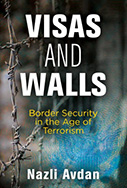Visas And Walls: Border Security In The Age Of Terrorism

Author: Nazli Avdan
Publisher: Philadelphia: University of Pennsylvania Press, 2019. 256p.
Reviewer: George Gavrilis | March 2020
Mention borders today and you will likely get one of two responses: One is that borders are bad, they divide people, keep families apart, and violate basic human rights. A second is that borders are broken, don’t protect the country from bad folks who wish to do bad things, and that they need to be bolstered by walls—the bigger the better. Both responses start from ideological positions: Empathetic liberals who make the first claim are, in essence, saying that states have no right to police their territories or uphold what it means to be a citizen.
Right-wing zealots fear that migrants will destroy their country even as they conveniently forget where their ancestors came from, while filling shopping carts with products made in China. In turbulent times, people can become edgy, extreme, and downright illogical.
This is why books like Visas and Walls are important. Nazlı Avdan’s study of border management pushes aside such popular narratives and tries to understand how borders work. She does this through a narrow but very useful frame: terrorism. Visas and Walls argues that borders are not just backdrops for photo opportunities so politicians can look tough as protectors of the nation. Borders play important security functions, but in ways that can seem puzzling. One state responds to terrorism by building walls and toughening visas, while for another state, it’s business as usual. What explains this?
Avdan’s answer is simple and elegant. States are much more likely to make borders tighter, more restrictive when they or their citizens are targeted directly in terror attacks. States are much less responsive when terror attacks are global in nature, particularly if border restrictions come with large economic costs. She explains why some attacks matter more than others:
From the perspective of the United States, the London bombing on July 7, 2005, was more threatening than the Bali attacks in the same year because the latter incident was culturally distant to U.S. interests. The contrasting public responses to international events also clues us in on a simpler distinction: that between directed and diffuse threats. Violence that is geographically or culturally proximate strikes closer to us.
More simple than that, however, attacks in our own backyard and against our compatriots strike closest to us. Terrorism is more likely to produce harder borders if the state’s own interests are involved, that is, if its own nationals are hurt in attacks or if terrorists execute attacks on the state’s own territory (p5).
Avdan’s book builds on the work of Peter Andreas who explained that borders in the 21st century were less about protecting against military threats and more about regulating flows of goods and people. While borders became more open to economic exchange, policymakers found new ways of selectively restricting borders against threats like smuggling and cross-border terrorism—threats that Andreas referred to as clandestine transnational actors.
Visa and Walls picks up on this taxonomy and should be read alongside Andreas’ path-breaking book, Border Games: Policing the U.S.-Mexico Border (Cornell University Press). Originally published in 2000 and reissued after the 9/11 attacks, Andreas wrote, “[m]uch of this recent escalation, it should be emphasized, has involved repackaging pre-September 11 border control ideas and instruments as ‘new’ antiterrorism programs and initiatives.” What was new is that officials now found more nuanced ways to target transnational threats like terror networks.
Avdan’s key qualification here is that all terror attacks are not perceived the same way, and that economic concerns can under some conditions dampen the response at the border.
This work reflects an important dimension of border control that also appears in my own work, The Dynamics of Interstate Boundaries (Cambridge University Press, 2008). Studying the borders of new states, I argued that governments don’t respond evenly to security threats like cross-border terrorism, but instead tailor their border control policies to suit the country’s favored path of state building and to ensure revenue that allows them to pursue that path. For example, states that rely on trade are extremely resistant to restricting their borders, even in the wake of cross-border terror. My view is that economics almost always (not just sometimes) trumps security at the border, and Avdan misses an opportunity here to explain why I might have been wrong.
The point is that readers who are interested in the subject of borders will find themselves with a list of great books. This includes work that doesn’t feature in Visas and Walls but that is great at explaining some of the odd dynamics of border control. For example, in Line in the Sand: A History of the Western US-Mexico Border, historian Rachel St. John lays out the fascinating history of a border that is in the news constantly. In Paper Citizens: How Illegal Immigrants Acquire Citizenship in Developing Countries (Oxford University Press, 2009) Kamal Sadiq explains some of the ways that migrants get around visa and citizenship policies and thus evade restrictive border control policies.
Nazli Avdan’s book is unique in its position on the shelf because it is the first to quantitatively assess the links between border and visa policies and terrorism, and that alone makes it worthy of attention despite some missed opportunities. The long analysis of statistical methods and results displaces what could have been a more detailed discussion of policy implications. Can policymakers do anything to make smarter and better borders, or are they servants to the causal mechanism she describes? Avdan points to the growing problem policymakers face now that ISIL fighters are returning to Europe and elsewhere, but I wanted to hear more on what specific border control policies ought to be implemented.
The book resoundingly rejects the usual dichotomies of open versus closed borders in favor of a nuanced treatment of borders as sets of policy options that allow policymakers to fine-tune and target restrictions. But this doesn’t go quite far enough. Many borders around the world, particularly in higher-income countries, use risk-management principles; border guards and customs officials do lots of risk management and profiling in hopes of snaring illicit goods or sketchy individuals without slowing the movement of trade or money-wielding tourists. Risk management doesn’t always work well, and sometimes it fails entirely, but the point is that a state does not have to close a border or deny visas to police against terrorism. It’s highly likely that looking at risk analysis practices at borders would strengthen Avdan’s argument rather than take away from it.
Although this is largely a quantitative study, Avdan’s narrative shines in her illustrative case study of Turkey — a study which is thoroughly written and vitally important. Readers should pay close attention as what happens along Turkey’s borders matters to the rest of Europe. They will also enjoy the chapter on border walls, which explains who is building them and why. It bolsters Avdan’s argument and would make wall-building, populist leaders around the world snort in annoyance to learn that the levers of border control are not fully in their grip.
George Gavrilis, Fellow, Center for Democracy, Toleration, and Religion – University of California, Berkeley


